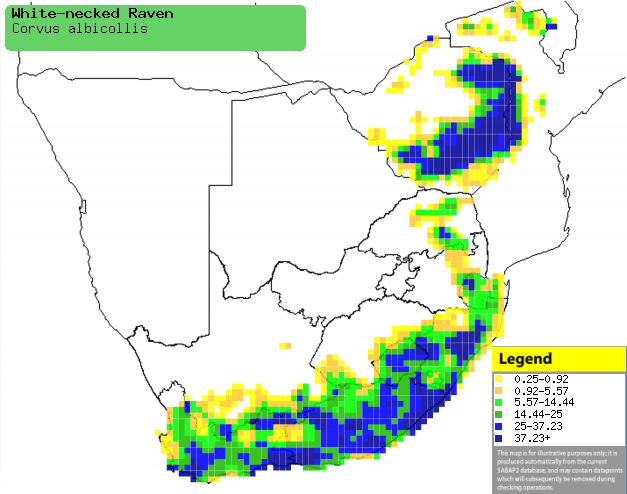|
Corvus albicollis (White-necked
raven)
Withalskraai [Afrikaans]; Ihlungulu, Igrwababa, Umfundisi
[Xhosa]; iHubulu, iWabayi [Zulu]; Lekhoaba, Moqukubi [South Sotho]; Gwavava,
Ukuuku [Tsonga]; Witnekraaf [Dutch]; Corbeau à nuque blanche [French];
Geierrabe [German]; Corvo-das-montanhas [Portuguese]
Life > Eukaryotes > Opisthokonta > Metazoa (animals) > Bilateria > Deuterostomia > Chordata > Craniata > Vertebrata (vertebrates) > Gnathostomata (jawed vertebrates) > Teleostomi (teleost fish) > Osteichthyes (bony fish) > Class: Sarcopterygii (lobe-finned fish) > Stegocephalia (terrestrial vertebrates) > Tetrapoda (four-legged vertebrates) > Reptiliomorpha > Amniota > Reptilia (reptiles) > Romeriida > Diapsida > Archosauromorpha > Archosauria > Dinosauria (dinosaurs) > Saurischia > Theropoda (bipedal predatory dinosaurs) > Coelurosauria > Maniraptora > Aves (birds) > Order: Passeriformes > Family: Corvidae
Distribution and habitat
Occurs in a band from Kenya and Tanzania through Malawi to
southern Africa. Here it is restricted to areas of Zimbabwe, Lesotho, Swaziland,
the Western and Eastern Capes, KwaZulu-Natal and the Limpopo Province. It
generally favours rocky or mountainous areas, often hunting in adjacent plains
and even in the more open areas of cities.
|
 |
|
Distribution of White-necked raven in southern Africa,
based on statistical smoothing of the records from first SA Bird Atlas
Project (©
Animal Demography unit, University of
Cape Town; smoothing by Birgit Erni and Francesca Little). Colours range
from dark blue (most common) through to yellow (least common).
See here for the latest distribution
from the SABAP2. |
Food
It is a highly adaptable feeder, eating a variety of
insects, birds, small mammals, reptiles and fruit, among other things. It often
scavenges on roadkills in the Karoo and steals eggs from other birds nests. It
also picks up tortoises in its bill and drops them about 15 metres onto rocks,
which (sometimes after several tries) cracks open the shell so that it can eat
the juicy insides. The following food items have been recorded in its diet:
- Animals
- insects
- reptiles
- birds
- Small mammals
- Plants
- nectar of Aloe marlothii (Mountain aloe)
- fruit
- cereal grains
Breeding
- The nest is a large cup of twigs lined with with hair, grass and wool and
placed on an almost inaccessible ledge or hole in a cliff.
- Egg-laying season is from about July-November, peaking around
September-October.
- It lays 2-5, usually 4 eggs which are incubated for about 21-26 days.
- In one observation, the chicks were fed and cared for solely by the
female, leaving the nest after 38 days.
Threats
Not threatened, in fact quite common in protected areas.
References
-
Hockey PAR, Dean WRJ and Ryan PG 2005. Roberts
- Birds of southern Africa, VIIth ed. The Trustees of the John Voelcker
Bird Book Fund, Cape Town.
|
